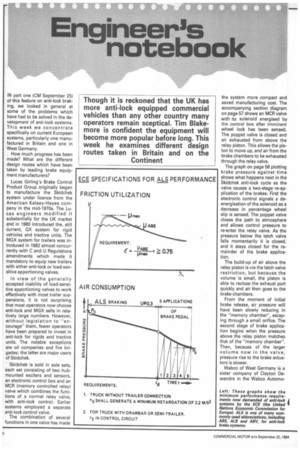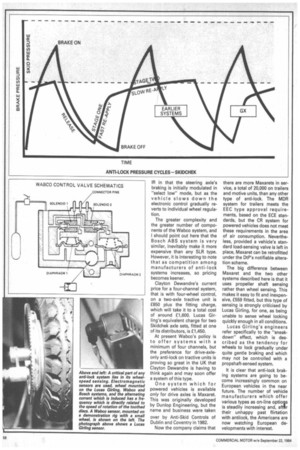Engineer's notebook
Page 58

Page 59

Page 60

If you've noticed an error in this article please click here to report it so we can fix it.
IN part one (CM September 25) of this feature on anti-lock braking, we looked in general at some of the problems which have had to be solved in the development of anti-lock systems. This week we concentrate specifically on current European systems, particularly one manufactured in Britain and one in West Germany.
How much progress has been made? What are the different design routes which have been taken by leading brake equipment manufacturers?
Lucas Girling's Brake Control Product Group originally began to manufacture the Skidchek system under licence from the American Kelsey-Hayes company in the mid-1970s. The Lucas engineers modified it substantially for the UK market and in 1980 introduced the, still current, GX system for rigid vehicles and tractive units. The MGX system for trailers was introduced in 1982 almost concurrently with C and U Regulations amendments which made it mandatory to equip new trailers with either anti-lock or load-sensitive apportioning valves.
In view of the generally accepted inability of load-sensitive apportioning valves to work effectively with most trailer suspensions, it is not surprising that most operators now choose anti-lock and MGX sells in relatively large numbers. However, without legislation to "encourage" them, fewer operators have been prepared to invest in anti-lock for rigids and tractive units. The notable exceptions are oil companies and fire brigades; the latter are major users of Skidchek.
Skidchek is sold in axle sets, each set consisting of two hubmounted exciters and sensors, an electronic control box and an MCR )memory controlled relay) valve which combines the functions of a normal relay valve, with anti-lock control. Earlier systems employed a separate anti-lock control valve.
The combination of several functions in one valve has made the system more compact and saved manufacturing cost. The accompanying section diagram on page 57 shows an MCR valve with its solenoid energised by the control box after imminent wheel lock has been sensed. The poppet valve is closed and air exhausted from above the relay piston. This allows the piston to move up, and air from the brake chambers to be exhausted through the relay valve.
The graph on page 58 plotting brake pressure against time shows what happens next in the Skidchek anti-lock cycle as the valve causes a two-stage re-application of the brakes. First the electronic control signals a deenergisation of the solenoid as a decrease in percentage wheel slip is sensed. The poppet valve closes the path to atmosphere and allows control pressure to re-enter the relay valve. As the pressure below the latch valve falls momentarily it is closed, and it stays closed for the remainder of the brake application.
The build-up of air above the relay piston is via the latch valve restriction, but because the volume is small, the piston is able to reclose the exhaust port quickly and air then goes to the brake chambers.
From the moment of initial brake release, air pressure will have been slowly reducing in the "memory chamber", escaping through a small orifice. The second stage of brake application begins when the pressure above the relay piston matches that of the "memory chamber". Then, because of the larger volume now in the valve, pressure rise to the brake actuators is slower.
Wabco of West Germany is a sister company of Clayton Dewandre in the Wabco Automo tive Products division of the American Standard group. There are also Wabco companies in France, Italy, Austria and Sweden. Though the letters of the name do come from the initials of the Westinghouse Air Brake Company, there is now no connection between Wabco and Westinghouse.
The full history of the interconnections between various brake equipment manufactur ers, including Westinghouse and Bendix, warrants a separate story of its own. As far as Wabco anti-lock systems are concerned, they are now manu factured in West Germany and marketed in the UK by Clayton Dewandre.
Wabco began its development of anti-lock systems some eight or nine years ago jointly with Daimler-Benz which now offers them as an on-line option. The Bosch ABS system is fitted to Mercedes-Benz cars.
The design of Wabco's solenoid control valve is different from that of Lucas Girling; for example, it has two separate solenoids, though it achieves a similar sort of control over the increase, decrease or hold of pressure in the brake chamber.
However, there are significant differences between the type of electronic control used by Wabco and Lucas Girling. The former system is digital while Skidchek's is analogue.
Another significant difference between the two is that Wabco's anti-lock system controls indi vidual wheels and thus requires one control valve per wheel whereas the Skidchek system is one of the axle by axle SLR (select low regulation) type.
This type of system modulates braking force on each axle according to the demands of the wheel on that axle which is tending to skid most. In other words, if the offside wheel is on a low coefficient of friction surface while the nearside wheel is on a higher friction surface, braking pressure will be modulated in line with the offside.
The argument in favour of IR (individual wheel regulation) as opposed to SLR is that the latter will give longer stopping distances on split t surfaces such as that described. However, a simple IR system on a steering axle would cause its own problems on such a surface because a yawing moment would be induced (that is the vehicle would tend to spin) as a result of the lateral braking imbalance.
Wabco's solution to this particular problem is to use what is described as MIR (modified individual wheel regulation). This is effectively a mixture of SLR and Above and left: A critical part of any anti-lock system lies in its wheelspeed sensing. Electromagnetic sensors are used, wheel mounted on the Lucas Girling, Wabco and Bosch systems, and the alternating current which is induced has a frequency which is directly related to the speed of rotation of the toothed discs. A Wabco sensor, mounted on a demonstration rig with a small wheel, is shown on the left. The photograph above shows a Lucas Girling sensor. IR in that the steering axle's braking is initially modulated in "select low" mode, but as the vehicle slows down the electronic control gradually reverts to individual wheel regulation.
The greater complexity and the greater number of components of the Wabco system, and I should point out here that the Bosch ABS system is very similar, inevitably make it more expensive than any SLR type. However, it is interesting to note that as competition among manufacturers of anti-lock systems increases, so pricing becomes keener.
Clayton Dewandre's current price for a four-channel system, that is with four-wheel control, on a two-axle tractive unit is £850 plus the fitting charge, which will take it to a total cost of around £1,600. Lucas Girling's equivalent charge for two Skidchek axle sets, fitted at one of its distributors, is £1,450.
At present Wabco's policy is to offer systems with a minimum of four channels, but the preference for drive-axleonly anti-lock on tractive units is proving so great in the UK that Clayton Dewandre is having to think again and may soon offer a system of this type.
One system which for powered vehicles is available only for drive axles is Maxaret. This was originally developed by Dunlop Engineering, but the name and business were taken over by Anti-Skid Controls of Dublin and Coventry in 1982. Now the company claims that there are more Maxarets in service, a total of 20,000 on trailers and motive units, than any other type of anti-lock. The MDR system for trailers meets the EEC type approval requirements, based on the ECE standards, but the CR system for powered vehicles does not meet these requirements in the area of air consumption. Nevertheless, provided a vehicle's standard load-sensing valve is left in place, Maxaret can be retrofitted under the DtP's notifiable alteration scheme.
The big difference between Maxaret and the two other systems described here is that it uses propeller shaft sensing rather than wheel sensing. This makes it easy to fit and inexpensive, £559 fitted, but this type of sensing is strongly criticised by Lucas Girling, for one, as being unable to sense wheel locking quickly enough in all conditions.
Lucas Girling's engineers refer specifically to the "sneakdown" effect, which is described as the tendency for wheels to lock gradually under quite gentle braking and which may not be controlled with a propshaft-sensed system.
It is clear that anti-lock braking systems are going to become increasingly common on European vehicles in the near future. The number of vehicle manufacturers which offer various types as on-line optiogs is steadily increasing and, aftgr their unhappy past flirtation with antilock, the Americans are now watching European developments with interest.




























































































